Turbulence Effects in Tilting Pad Journal Bearings: A Review
Abstract
1. Introduction
2. Numerical Investigations
2.1. Turbulence Models
2.2. Numerical Analysis
2.2.1. Studies Based on Generalized Reynolds Equations
2.2.2. Studies Based on the CFD Simulations
2.3. Effect of Turbulence on the Bearing Performances
3. Experimental Works
3.1. Experimental Investigations with Turbulence
3.2. Evidence for Turbulence Transition
3.3. Effects of Parameters on Turbulent Transition
3.4. Some Objections to the Evidence of Turbulent Transition in the Hydrodynamic Film
3.5. Analysis of Transitional Reynolds Number
4. Conclusions and Future Developments
- Turbulent flow in thin films can be approximately described as laminar flow, with an effective anisotropic non-homogeneous viscosity and an effective anisotropic non-homogeneous thermal conductivity.
- Turbulent flow in TPJBs generally gives more load capacity, more power loss, higher stiffness coefficients, and higher thermal exchange between the fluid and the surfaces in contact.
- A desirable effect of turbulence is the decrease of the loaded pads highest temperature, while an undesirable one is the increase in power loss. Some of the latest research efforts aim to exploit the first while avoiding or limiting the latter.
- At present, grid points for the hydrodynamic film are considered enough in turbulent TEHL or THL simulations, distributed mostly along the circumferential direction or across the film thickness. This number can be reduced by one or two orders of magnitudes for turbulent HL simulations.
- In a turbulent THL simulation, if the number of points across the film thickness is much lower than 100, extra attention should be put on the convergence of the solution.
- For CFD simulations, most authors employ the RANS framework and simulate a portion of the bearing, i.e., the hydrodynamic film of a single pad, or the secondary flow between pads. Currently, one of the most used models is the SST turbulence model. In a RANS CFD simulation, grid points are considered enough for the hydrodynamic film of a single pad.
- The field of turbulence modelling is rich and in continuous evolution. In the future, larger domains and different turbulence models are expected to be employed.
- Some numerical works compare their calculations on experimental works which are a few decades old. Future CFD and TEHL numerical researchers are suggested to consider benchmarking their calculations against more recent experimental works with, for instance, refined spatial measurement resolution of fluid film properties [66], or confidence intervals to the measurements [83].
- In most experiments reported here, LTT occurs in TPJBs at Reynolds number of , provided that the Reynolds number is calculated with the oil supply temperature. More precise predictions would require knowledge of the local Reynolds number.
- Experimental works which aim to detect LTT should report as much independent evidence as possible by considering the different methods reported in this work, keeping in mind that indirect evidence is a sufficient but not a necessary condition for turbulent flow.
- There is a need for advanced experimental techniques to monitor velocity and temperature in thick, oil-lubricated films to provide valuable data for numerical studies, detect LTT and validate experimental indirect transition methods.
- There is a need for experiments with a denser number of rpm points in the proximity of LTT.
- The papers published in the literature should be provided with sufficient design details and material properties to allow other researchers to use them for comparison and model validation.
- The mixed lubrication performance of tilting pad journal bearings in a turbulent state may be investigated in case the bearing is heavily loaded or subjected to impact loads.
Author Contributions
Funding
Data Availability Statement
Conflicts of Interest
Abbreviations
| B&S | Ball and socket |
| CFD | Computational fluid dynamics |
| DL | Direct lubrication |
| EC | Elliptical contact |
| FDM | Finite difference method |
| FEM | Finite element method |
| FL | Flooded lubrication |
| FP | Flexural pivot |
| FVM | Finite volume method |
| HL | Hydrodynamic lubrication |
| LBP | Load between pads |
| LDA | Laser doppler anemometry |
| LEG | Leading edge groove |
| LOP | Load on pads |
| LTT | Laminar-to-turbulent transition |
| ODT | Oil discharge temperature |
| PITV | Pad inlet temperature variance |
| PLI | Power loss increase |
| PMT | Pad maximum temperature |
| RANS | Reynolds-averaged Navier-Stokes |
| RB | Rocker back |
| RMS | Root mean square |
| SMT | Shaft maximum temperature |
| SST | Shear stress transport |
| TEG | Trailing edge groove |
| TEHL | Thermo-elasto-hydrodynamic lubrication |
| THL | Thermo-hydrodynamic lubrication |
| TPJB | Tilting pad journal bearing |
Nomenclature
| h | Film thickness |
| Turbulent coefficients | |
| p | Pressure |
| rpm | Rounds per minute |
| C | Radial clearance |
| D | Nominal diameter |
| L | Axial length |
| Average circumferential Reynolds number | |
| Local Reynolds number | |
| Critical Reynolds number for Taylor vortices | |
| Rθ | Pad arc length |
| U | Journal surface speed |
| µ | Dynamic viscosity |
| ν | Kinematic viscosity |
| Ω | Shaft angular speed |
References
- Deckler, D.C.; Veillette, R.J.; Braun, M.J.; Choy, F.K. Simulation and Control of an Active Tilting-Pad Journal Bearing. Tribol. Trans. 2004, 47, 440–458. [Google Scholar] [CrossRef]
- Frêne, J.; Nicolas, D.; Degueurce, B.; Berthe, D.; Godet, M. Hydrodynamic Lubrication: Bearings and Thrust Bearings, 1st ed.; Dowson, D., Ed.; Tribol. Ser.; Elsevier: Amsterdam, The Netherlands, 1997; Volume 33, ISBN 9780444823663. [Google Scholar]
- Lou, M.; Bareille, O.; Chai, W.; Ichchou, M.; Chen, W. Global Sensitivity Analysis of Static Characteristics of Tilting-Pad Journal Bearing to Manufacturing Tolerances. Tribol. Int. 2020, 149, 105734. [Google Scholar] [CrossRef]
- Taylor, C.M.; Dowson, D. Turbulent Lubrication Theory—Application to Design. J. Lubr. Technol. 1974, 96, 36–46. [Google Scholar] [CrossRef]
- Szeri, A.Z. Some Extensions of the Lubrication Theory of Osborne Reynolds. J. Tribol. 1987, 109, 21–36. [Google Scholar] [CrossRef]
- Taylor, G. Stability of a Viscous Liquid Contained between Two Rotating Cylinders. Philos. Trans. R. Soc. Lond. 1923, 223, 289–343. [Google Scholar] [CrossRef]
- Wilcock, D.F. Super Laminar Flow in Bearings: A Review of the Second Leeds-Lyon Symposium, Lyons, France, 17–19 September 1975. J. Lubr. Technol. 1976, 98, 5–7. [Google Scholar] [CrossRef][Green Version]
- Hopf, G.; Schüler, D. Investigations on Large Turbine Bearings Working under Transitional Conditions between Laminar and Turbulent Flow. J. Tribol. 1989, 111, 628–634. [Google Scholar] [CrossRef]
- Mittwollen, N.; Glienicke, J. Operating Conditions of Multi-Lobe Journal Bearings Under High Thermal Loads. J. Tribol. 1990, 112, 330–338. [Google Scholar] [CrossRef]
- Macken, N.A.; Saibel, E.A. Turbulence and Inertia Effects in Bearings. Tribology 1972, 5, 154–160. [Google Scholar] [CrossRef]
- DiPrima, R.C.; Stuart, J.T. Non-Local Effects in the Stability of Flow between Eccentric Rotating Cylinders. J. Fluid Mech. 1972, 54, 393–415. [Google Scholar] [CrossRef]
- Schmitt, F.G. About Boussinesq’s Turbulent Viscosity Hypothesis: Historical Remarks and a Direct Evaluation of Its Validity. Comptes Rendus Mécanique 2007, 335, 617–627. [Google Scholar] [CrossRef]
- Constantinescu, V.N. Basic Relationships in Turbulent Lubrication and Their Extension to Include Thermal Effects. J. Lubr. Technol. 1973, 95, 147–154. [Google Scholar] [CrossRef]
- Constantinescu, V.N. On Turbulent Lubrication. Proc. Inst. Mech. Eng. 1959, 173, 881–900. [Google Scholar] [CrossRef]
- Prandtl, L. Bericht Über Untersuchungen Zur Ausgebildeten Turbulenz. J. Appl. Math. Mech. 1925, 5, 136–139. [Google Scholar] [CrossRef]
- Ng, C.W.; Pan, C.H.T. A Linearized Turbulent Lubrication Theory. J. Basic Eng. 1965, 87, 675–682. [Google Scholar] [CrossRef]
- Elrod, H.G.; Ng, C.W. A Theory for Turbulent Fluid Films and Its Application to Bearings. J. Lubr. Technol. 1967, 89, 346–362. [Google Scholar] [CrossRef]
- Hirs, G.G. A Bulk-Flow Theory for Turbulence in Lubricant Films. J. Lubr. Technol. 1973, 95, 137–145. [Google Scholar] [CrossRef]
- Ho, M.-K.; Vohr, J.H. Application of Energy Model of Turbulence to Calculation of Lubricant Flows. J. Lubr. Technol. 1974, 96, 95–102. [Google Scholar] [CrossRef]
- Harada, M.; Aoki, H. Analysis of Thrust Bearings Operating in Turbulent Regime. J. Tribol. 1988, 110, 555–560. [Google Scholar] [CrossRef]
- Hashimoto, H.; Wada, S. Theoretical Approach to Turbulent Lubrication Problems Including Surface Roughness Effects. J. Tribol. 1989, 111, 17–22. [Google Scholar] [CrossRef]
- Tieu, A.K.; Kosasih, P.B. An Expression of Reynolds Stresses in Turbulent Lubrication Theory. J. Tribol. 1992, 114, 57–60. [Google Scholar] [CrossRef]
- Bouard, L.; Fillon, M.; Frêne, J. Comparison between Three Turbulent Models—Application to Thermohydrodynamic Performances of Tilting-Pad Journal Bearings. Tribol. Int. 1996, 29, 11–18. [Google Scholar] [CrossRef]
- Szeri, A.Z. Tribology: Friction, Lubrication and Wear; McGraw-Hill: New York, NY, USA, 1980; ISBN 978-0070626638. [Google Scholar]
- Armentrout, R.W.; He, M.; Haykin, T.; Reed, A.E. Analysis of Turbulence and Convective Inertia in a Water-Lubricated Tilting-Pad Journal Bearing Using Conventional and CFD Approaches. Tribol. Trans. 2017, 60, 1129–1147. [Google Scholar] [CrossRef]
- Ding, A.; Ren, X.; Li, X.; Gu, C. Numerical Investigation of Turbulence Models for a Superlaminar Journal Bearing. Adv. Tribol. 2018, 2018, 2841303. [Google Scholar] [CrossRef]
- Spalart, P.; Allmaras, S. A One-Equation Turbulence Model for Aerodynamic Flows. In Proceedings of the 30th Aerospace Sciences Meeting and Exhibit, Reno, NV, USA, 6–9 January 1992; American Institute of Aeronautics and Astronautics: Reston, VA, USA, 1992. [Google Scholar]
- Launder, B.E.; Spalding, D.B. The Numerical Computation of Turbulent Flows. Comput. Methods Appl. Mech. Eng. 1974, 3, 269–289. [Google Scholar] [CrossRef]
- Wilcox, D.C. Formulation of the K-w Turbulence Model Revisited. AIAA J. 2008, 46, 2823–2838. [Google Scholar] [CrossRef]
- Menter, F.R. Two-Equation Eddy-Viscosity Turbulence Models for Engineering Applications. AIAA J. 1994, 32, 1598–1605. [Google Scholar] [CrossRef]
- Menter, F.R. Review of the Shear-Stress Transport Turbulence Model Experience from an Industrial Perspective. Int. J. Comput. Fluid Dyn. 2009, 23, 305–316. [Google Scholar] [CrossRef]
- Manshoor, B.; Jaat, M.; Izzuddin, Z.; Amir, K. CFD Analysis of Thin Film Lubricated Journal Bearing. Procedia Eng. 2013, 68, 56–62. [Google Scholar] [CrossRef]
- Maneshian, B.; Nassab, S.A.G. Thermohydrodynamic Analysis of Turbulent Flow in Journal Bearings Running under Different Steady Conditions. Proc. Inst. Mech. Eng. Part J J. Eng. Tribol. 2009, 223, 1115–1127. [Google Scholar] [CrossRef]
- Durany, J.; Pereira-Pérez, J.; Varas, F. About the Constantinescu Turbulent Model in Hydrodynamic Lubrication: A Comparison with 3-D LES Models. Tribol. Int. 2015, 83, 33–41. [Google Scholar] [CrossRef]
- Abe, K.; Kondoh, T.; Nagano, Y. A New Turbulence Model for Predicting Fluid Flow and Heat Transfer in Separating and Reattaching Flows—I. Flow Field Calculations. Int. J. Heat Mass Transf. 1994, 37, 139–151. [Google Scholar] [CrossRef]
- Yang, J.; Palazzolo, A. Computational Fluid Dynamics Based Mixing Prediction for Tilt Pad Journal Bearing TEHD Modeling—Part I: TEHD-CFD Model Validation and Improvements. J. Tribol. 2021, 143, 011801. [Google Scholar] [CrossRef]
- Mermertas, Ü.; Hagemann, T.; Brichart, C. Optimization of a 900 Mm Tilting-Pad Journal Bearing in Large Steam Turbines by Advanced Modeling and Validation. J. Eng. Gas Turbines Power 2019, 141, 021033. [Google Scholar] [CrossRef]
- Bi, C.; Han, D.; Wu, Y.; Li, Y.; Yang, J. Thermohydrodynamic Investigation for Supercritical Carbon Dioxide High Speed Tilting Pad Bearings Considering Turbulence and Real Gas Effect. Phys. Fluids 2021, 33, 125114. [Google Scholar] [CrossRef]
- Mikami, M.; Kumagai, M.; Uno, S.; Hashimoto, H. Static and Dynamic Characteristics of Rolling-Pad Journal Bearings in Super-Laminar Flow Regime. J. Tribol. 1988, 110, 73–79. [Google Scholar] [CrossRef]
- Orcutt, F.K. The Steady-State and Dynamic Characteristics of the Tilting-Pad Journal Bearing in Laminar and Turbulent Flow Regimes. J. Lubr. Technol. 1967, 89, 392–400. [Google Scholar] [CrossRef]
- Okabe, E.P.; Cavalca, K.L. Rotordynamic Analysis of Systems with a Non-Linear Model of Tilting Pad Bearings Including Turbulence Effects. Nonlinear Dyn. 2009, 57, 481–495. [Google Scholar] [CrossRef]
- Jin, Y.; Yuan, X. Analytical Method for Hydrodynamic Force in Finite-Length Tilting-Pad Journal Bearing Including Turbulence Effect. J. Tribol. 2020, 142, 091802. [Google Scholar] [CrossRef]
- Taniguchi, S.; Makino, T.; Takeshita, K.; Ichimura, T. A Thermohydrodynamic Analysis of Large Tilting-Pad Journal Bearing in Laminar and Turbulent Flow Regimes with Mixing. J. Tribol. 1990, 112, 542–548. [Google Scholar] [CrossRef]
- Edney, S.L.; Heitland, G.B.; DeCamillo, S.M. Testing, Analysis, and CFD Modeling of a Profiled Leading Edge Groove Tilting Pad Journal Bearing. In Proceedings of the ASME Turbo Expo, Stockholm, Sweden, 2–5 June 1998; American Society of Mechanical Engineers: New York, NY, USA, 1998; Volume 5. 98-GT-409. [Google Scholar]
- Ikeda, K.; Hirano, T.; Yamashita, T.; Mikami, M.; Sakakida, H. An Experimental Study of Static and Dynamic Characteristics of a 580 mm (22.8 in.) Diameter Direct Lubrication Tilting Pad Journal Bearing. J. Tribol. 2006, 128, 146–154. [Google Scholar] [CrossRef]
- Arihara, H.; Kameyama, Y.; Baba, Y.; San Andrés, L. A Thermoelastohydrodynamic Analysis for the Static Performance of High-Speed—Heavy Load Tilting-Pad Journal Bearing Operating in the Turbulent Flow Regime and Comparisons to Test Data. J. Eng. Gas Turbines Power 2019, 141, 021023. [Google Scholar] [CrossRef]
- Hagemann, T.; Schwarze, H. Theoretical and Experimental Analyses of Directly Lubricated Tilting-Pad Journal Bearings with Leading Edge Groove. In Proceedings of the ASME Turbo Expo, Oslo, Norway, 11–15 June 2018; American Society of Mechanical Engineers: New York, NY, USA, 2018; Volume 7B-2018. GT2018-75659. [Google Scholar]
- Hagemann, T.; Zemella, P.; Pfau, B.; Schwarze, H. Experimental and Theoretical Investigations on Transition of Lubrication Conditions for a Five-Pad Tilting-Pad Journal Bearing with Eccentric Pivot up to Highest Surface Speeds. Tribol. Int. 2020, 142, 106008. [Google Scholar] [CrossRef]
- Buchhorn, N.; Stottrop, M.; Bender, B. Influence of Active Cooling at the Trailing Edge on the Thermal Behavior of a Tilting-Pad Journal Bearing. Lubricants 2021, 9, 26. [Google Scholar] [CrossRef]
- Bouard, L.; Fillon, M.; Frêne, J. Thermohydrodynamic Analysis of Tilting-Pad Journal Bearings Operating in Turbulent Flow Regime. J. Tribol. 1996, 118, 225–231. [Google Scholar] [CrossRef]
- Tanaka, M.; Hatakenaka, K. Turbulent Thermohydrodynamic Lubrication Models Compared with Measurements. Proc. Inst. Mech. Eng. Part J J. Eng. Tribol. 2004, 218, 391–399. [Google Scholar] [CrossRef]
- Hatakenaka, K. A New Turbulent Thermohydrodynamic Performance Analysis of Tilting Pad Journal Bearing Based on a K-ε Model and Comparison with Measurements. Trans. JSME 2015, 81, 15-00253. (In Japanese) [Google Scholar] [CrossRef]
- Hagemann, T.; Zeh, C.; Prölß, M.; Schwarze, H. The Impact of Convective Fluid Inertia Forces on Operation of Tilting-Pad Journal Bearings. Int. J. Rotating Mach. 2017, 2017, 5683763. [Google Scholar] [CrossRef]
- Ettles, C.M. The Analysis of Pivoted Pad Journal Bearing Assemblies Considering Thermoelastic Deformation and Heat Transfer Effects. Tribol. Trans. 1992, 35, 156–162. [Google Scholar] [CrossRef]
- Gardner, W.W.; Ulschmid, J.G. Turbulence Effects in Two Journal Bearing Applications. J. Lubr. Technol. 1974, 96, 15–20. [Google Scholar] [CrossRef]
- De Choudhury, P.; Masters, D.A. Performance Tests of Five-Shoe Tilting-Pad Journal Bearing. ASLE Trans. 1984, 27, 61–66. [Google Scholar] [CrossRef]
- Brockwell, K.R.; Kleinbub, D. Measurements of the Steady State Operating Characteristics of the Five Shoe Tilting Pad Journal Bearing. Tribol. Trans. 1989, 32, 267–275. [Google Scholar] [CrossRef]
- Croné, P.; Almqvist, A.; Larsson, R. Thermal Turbulent Flow in Leading Edge Grooved and Conventional Tilting Pad Journal Bearing Segments—A Comparative Study. Lubricants 2018, 6, 97. [Google Scholar] [CrossRef]
- Fillon, M.; Desbordes, H.; Frêne, J.; Chan Hew Wai, C. A Global Approach of Thermal Effects Including Pad Deformations in Tilting-Pad Journal Bearings Submitted to Unbalance Load. J. Tribol. 1996, 118, 169–174. [Google Scholar] [CrossRef]
- Carter, C.R. Measured and Predicted Rotordynamic Coefficients and Static Performance of a Rocker-Pivot Tilt Pad Bearing in Load-on-Pad and Load-between-Pad Configurations. M.S. Thesis, Texas A&M University, College Station, TX, USA, 2007. [Google Scholar]
- Kulhanek, C.D. Dynamic and Static Characteristics of a Rocker-Pivot, Tilting-Pad Bearing with 50% and 60% Offsets. M.S. Thesis, Texas A&M University, College Station, TX, USA, 2010. [Google Scholar]
- Someya, T.; Mitsui, J.; Esaki, J.; Saito, S.; Kanemitsu, Y.; Iwatsubo, T.; Tanaka, M.; Hisa, S.; Fujikawa, T.; Kanki, H. Journal-Bearing Databook; Springer Science & Business Media: Berlin, Germany, 2013. [Google Scholar]
- Yang, J.; Palazzolo, A. Three-Dimensional Thermo-Elasto-Hydrodynamic Computational Fluid Dynamics Model of a Tilting Pad Journal Bearing—Part I: Static Response. J. Tribol. 2019, 141, 061702. [Google Scholar] [CrossRef]
- Zemella, P.; Hagemann, T.; Pfau, B.; Schwarze, H. Identification of Dynamic Coefficients of a Five-Pad Tilting Pad Journal Bearing up to Highest Surface Speeds. J. Eng. Gas Turbines Power. 2021, 143, 081013. [Google Scholar] [CrossRef]
- Schüler, E.; Berner, O. Improvement of Tilting-Pad Journal Bearing Operating Characteristics by Application of Eddy Grooves. Lubricants 2021, 9, 18. [Google Scholar] [CrossRef]
- Hagemann, T.; Kukla, S.; Schwarze, H. Measurement and Prediction of the Static Operating Conditions of a Large Turbine Tilting-Pad Bearing under High Circumferential Speeds and Heavy Loads. In Proceedings of the ASME Turbo Expo, San Antonio, TX, USA, 3–7 June 2013; American Society of Mechanical Engineers: New York, NY, USA, 2013; Volume 7 B. GT2013-95004. [Google Scholar]
- Kukla, S.; Hagemann, T.; Schwarze, H. Measurement and Prediction of the Dynamic Characteristics of a Large Turbine Tilting-Pad Bearing under High Circumferential Speeds. In Proceedings of the ASME Turbo Expo, San Antonio, TX, USA, 3–7 June 2013; American Society of Mechanical Engineers: New York, NY, USA, 2013; Volume 7 B. GT2013-95074. [Google Scholar]
- Stottrop, M.; Buchhorn, N.; Bender, B. Experimental Investigation of a Large Tilting-Pad Journal Bearing—Comparison of a Flooded and Non-Flooded Design. Lubricants 2022, 10, 83. [Google Scholar] [CrossRef]
- Simmons, J.E.L.; Dixon, S.J. Effect of Load Direction, Preload, Clearance Ratio, and Oil Flow on the Performance of a 200mm Journal Pad Bearing. Tribol. Trans. 1994, 37, 227–236. [Google Scholar] [CrossRef]
- Ha, H.C.; Kim, H.J.; Kim, K.W. Inlet Pressure Effects on the Thermohydrodynamic Performance of a Large Tilting Pad Journal Bearing. J. Tribol. 1995, 117, 160–165. [Google Scholar] [CrossRef]
- Edney, S. Pad Temperature in High Speed, Lightly Loaded Tilting Pad Journal Bearings. In Proceedings of the 24th Turbomachinery Symposium, Houston, TX, USA, 26 September 1995; pp. 73–84. [Google Scholar]
- Bouchoule, C.; Fillon, M.; Nicolas, D.; Barresi, F. Experimental Study of Thermal Effects in Tilting-Pad Journal Bearings at High Operating Speeds. J. Tribol. 1996, 118, 532–538. [Google Scholar] [CrossRef]
- Ferraro, R.; Innocenti, A.; Libraschi, M.; Barsanti, M.; Ciulli, E.; Forte, P.; Nuti, M. Dynamic Identification of 280mm Diameter Tilting Pad Journal Bearings: Test Results and Measurement Uncertainties Assessment of Different Designs. In Proceedings of the ASME Turbo Expo, Virtual, Online, 21–25 September 2020; American Society of Mechanical Engineers: New York, NY, USA, 2020; Volume 10A-2020. GT2020-14718. [Google Scholar]
- Ciulli, E.; Ferraro, R.; Forte, P.; Innocenti, A.; Nuti, M. Experimental Characterization of Large Turbomachinery Tilting Pad Journal Bearings. Machines 2021, 9, 273. [Google Scholar] [CrossRef]
- Frêne, J.; Godet, M. Flow Transition Criteria in a Journal Bearing. J. Tribol. 1974, 96, 135–140. [Google Scholar] [CrossRef]
- Innes, G.E.; Leutheusser, H.J. An Investigation into Laminar-to-Turbulent Transition in Tilting-Pad Bearings. J. Tribol. 1991, 113, 303–307. [Google Scholar] [CrossRef]
- Tieu, A.K.; Kosasih, P.B.; Mackenzie, M.R. A Study of Fluid Velocities in Tribological Fluid Film. J. Tribol. 1994, 116, 133–138. [Google Scholar] [CrossRef]
- Nobis, M.; Reinke, P.; Schmidt, M.; Riedel, M.; Redlich, M. Investigation of the Velocity Distribution in the Flow of a Journal Bearing Model. EPJ Web Conf. 2014, 67, 02083. [Google Scholar] [CrossRef]
- Tropea, C. Laser Doppler Anemometry: Recent Developments and Future Challenges. Meas. Sci. Technol. 1995, 6, 605–619. [Google Scholar] [CrossRef]
- American Petroleum Institute. Machinery Protection Systems, 5th ed.; American Petroleum Institute: Washington, DC, USA, 2014. [Google Scholar]
- De Choudhury, P.; Barth, E.W. A Comparison of Film Temperatures and Oil Discharge Temperature for a Tilting-Pad Journal Bearing. J. Lubr. Technol. 1981, 103, 115–119. [Google Scholar] [CrossRef]
- Frêne, J. Tapered Land Thrust Bearing Operating in Both Laminar and Turbulent Regimes. ASLE Trans. 1978, 21, 243–249. [Google Scholar] [CrossRef]
- Barsanti, M.; Ciulli, E.; Forte, P. Random Error Propagation and Uncertainty Analysis in the Dynamic Characterization of Tilting Pad Journal Bearings. J. Phys. Conf. Ser. 2019, 1264, 012035. [Google Scholar] [CrossRef]
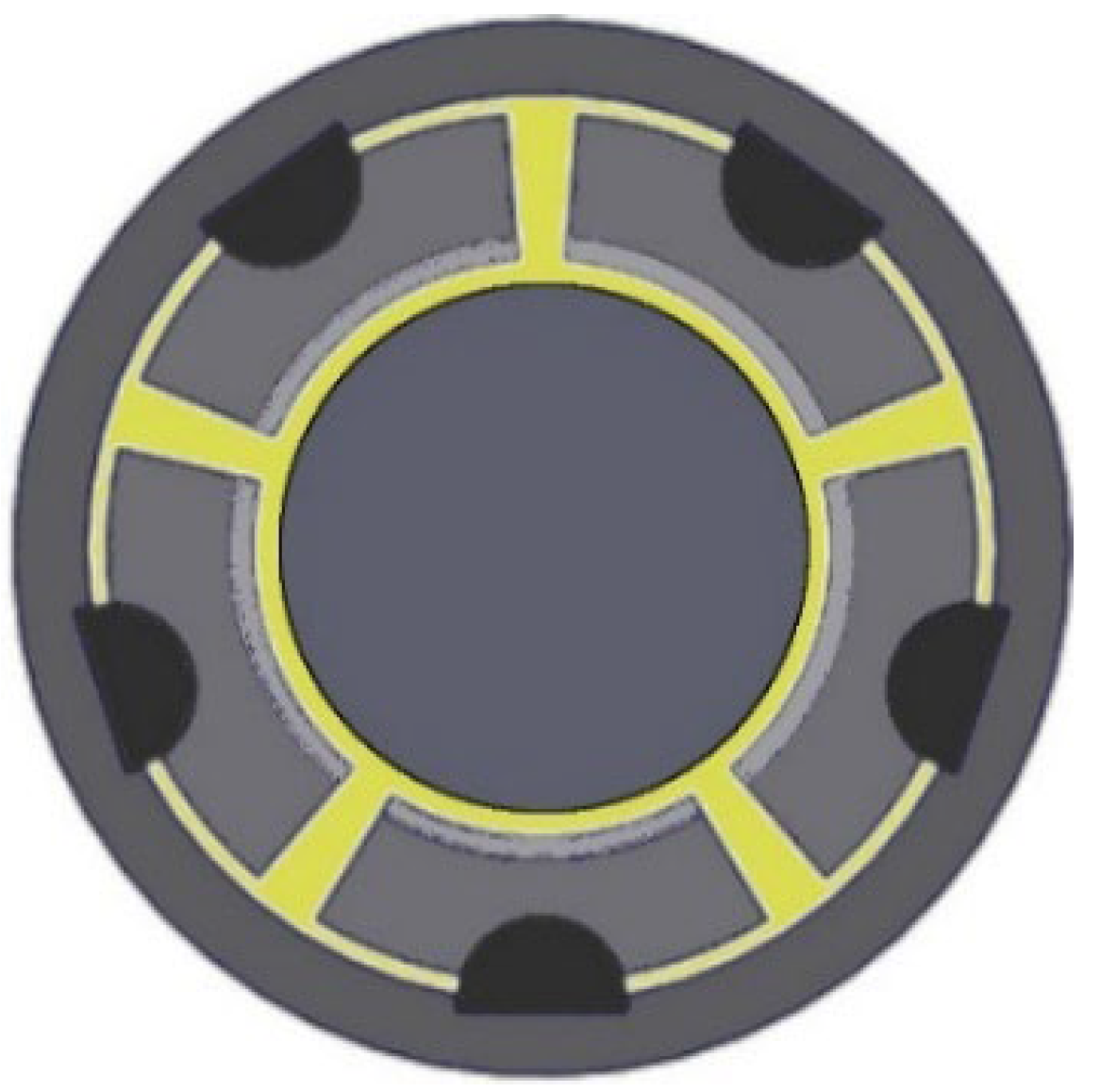
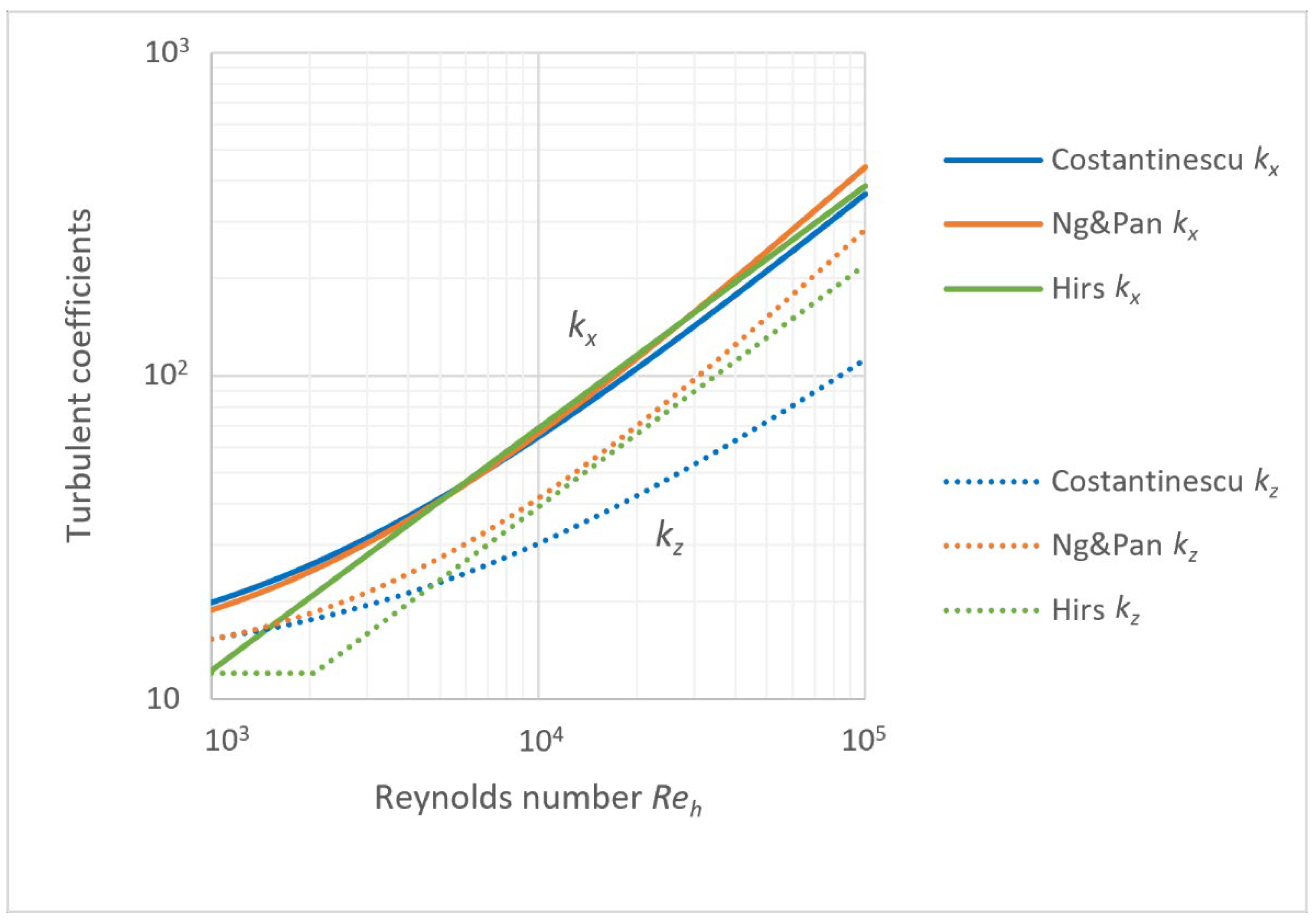
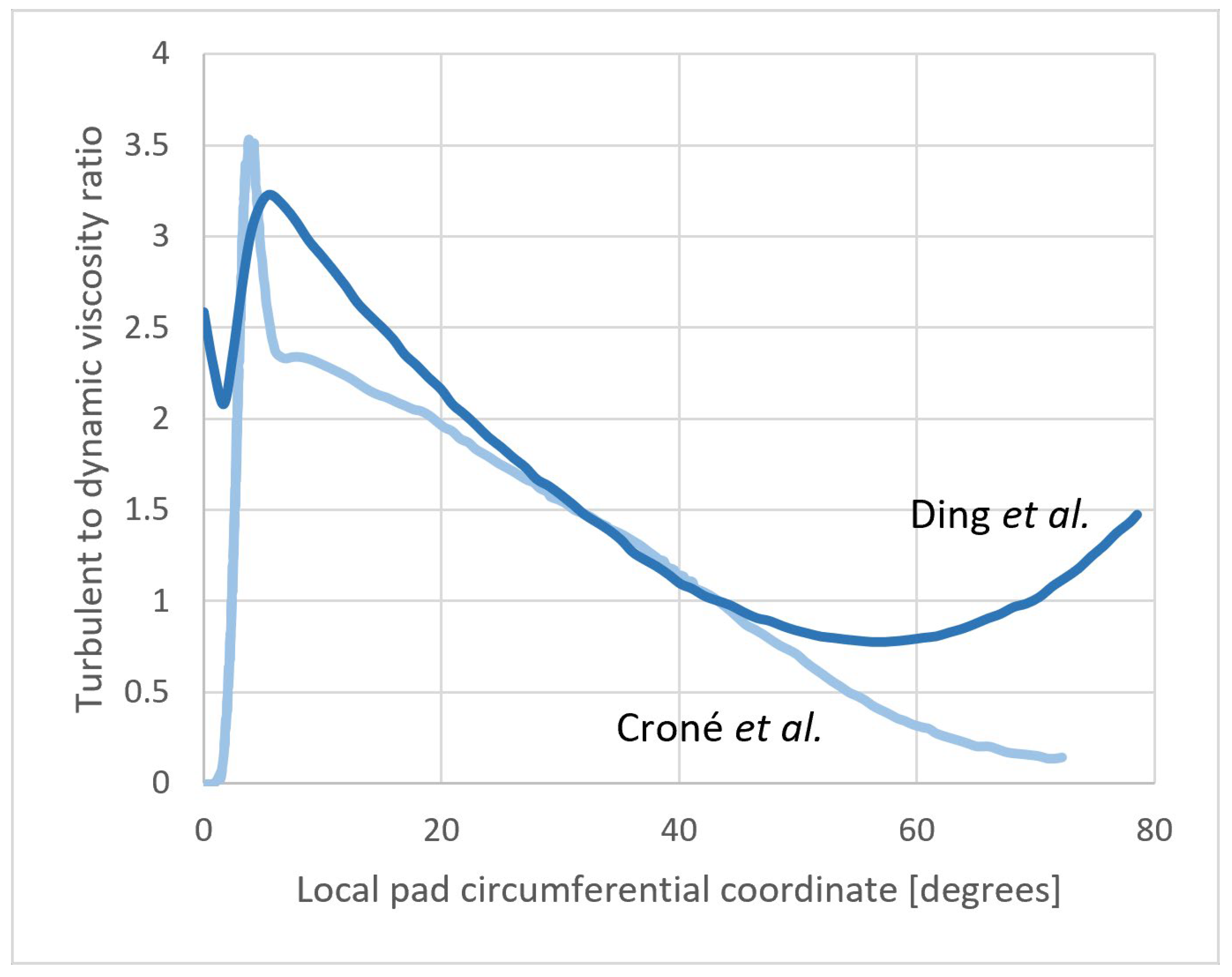
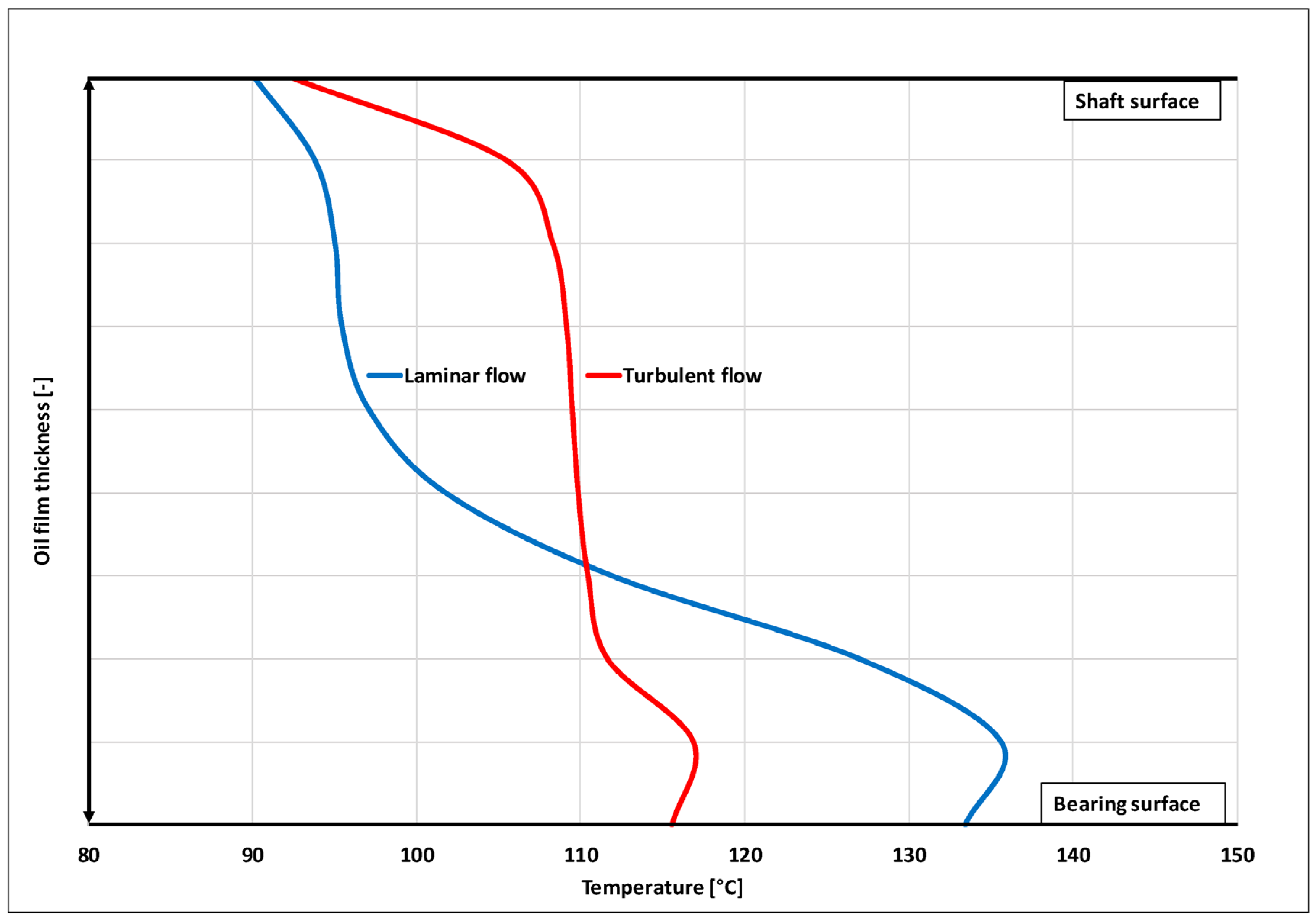
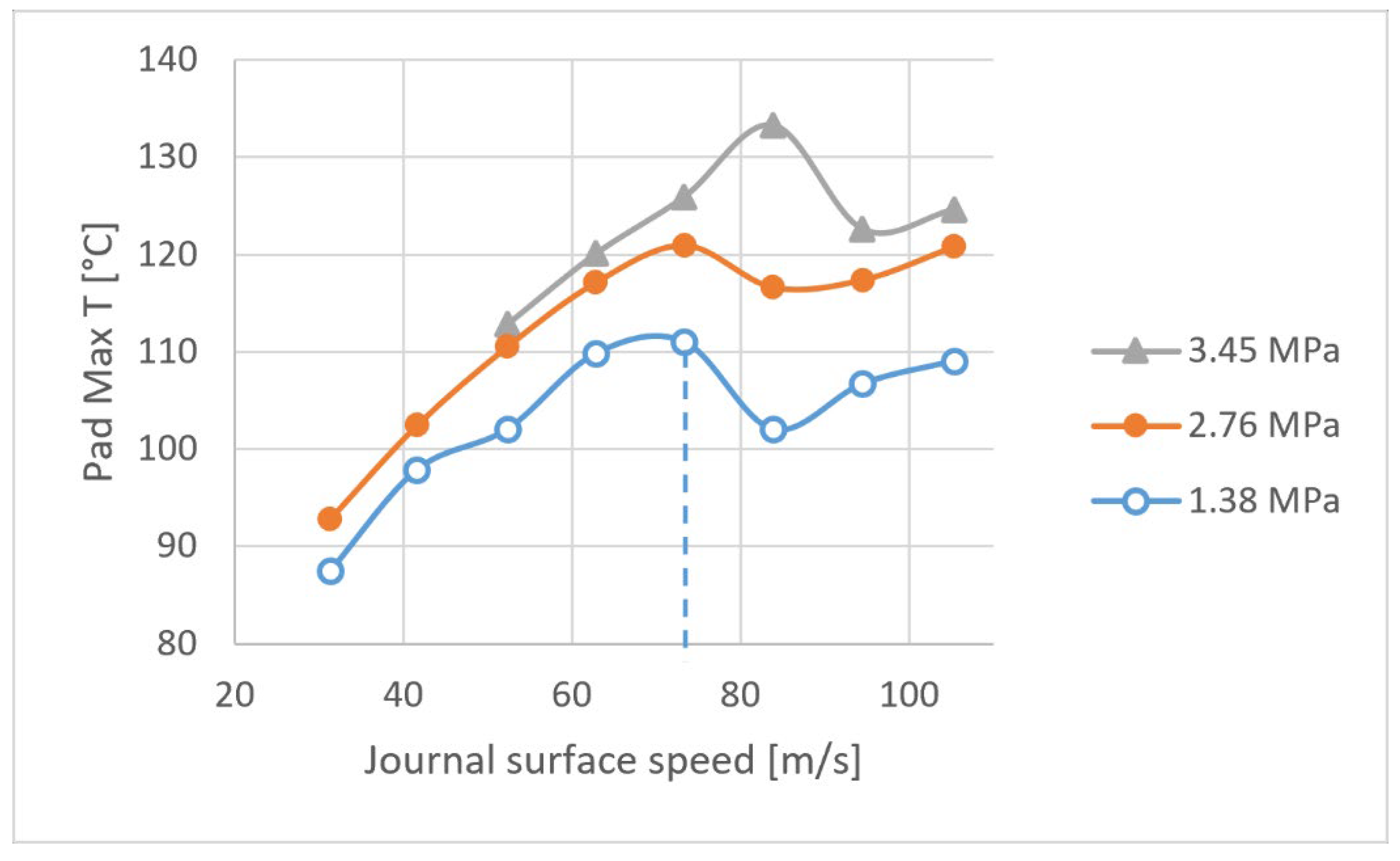
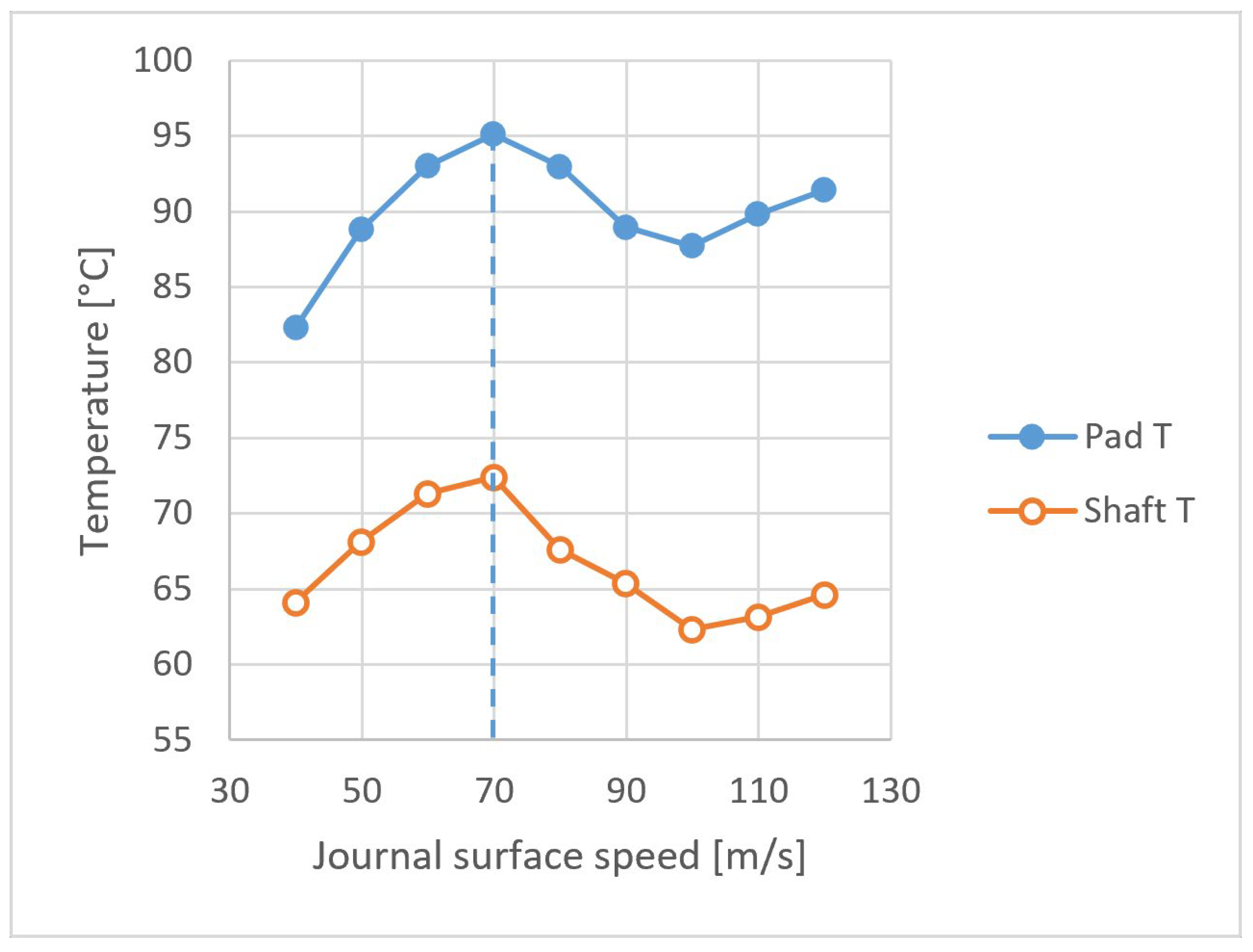

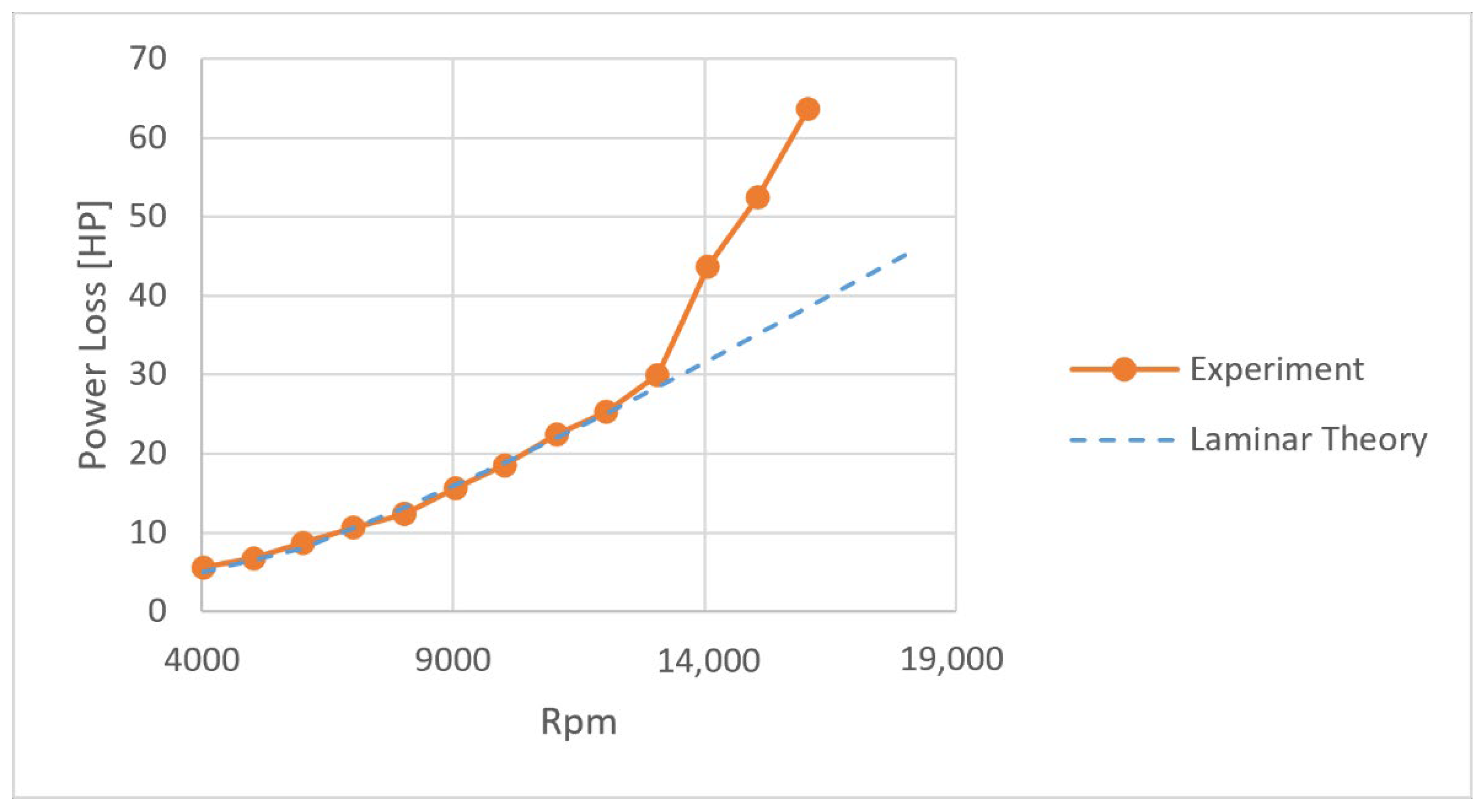
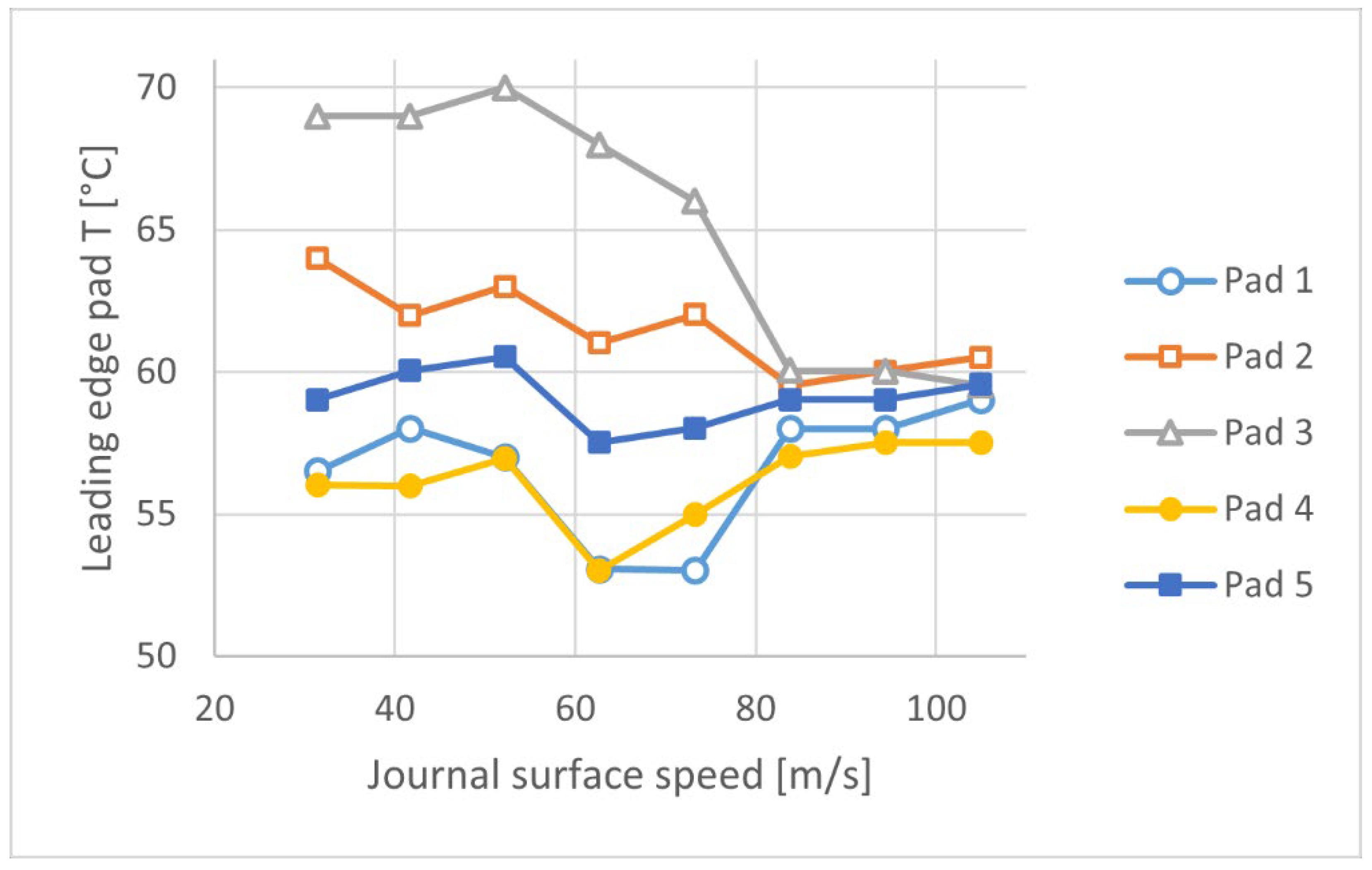
| Authors | Lubricant | Model 1 | Turbulence Model | Method 1 | Grid 2 R × θ × Z | Geometry 2 C × Rθ × L (mm) | Experimental Verification |
|---|---|---|---|---|---|---|---|
| Orcutt, 1967 [40] | Silicon oil | HL | Ng & Pan | - | - | - | Yes |
| Mikami et al., 1988 [39] | ISO VG 32 | THL | Aoki & Harada | - | - | - | Yes |
| Taniguchi et al., 1990 [43] | ISO VG 32 | THL | Ng & Pan | FDM | 9 × 9 × 9 | 0.612 × 334 × 300 | Yes |
| Ettles, 1992 [54] | - | TEHL | T boundary conditions | - | - | - | Yes, data from [43,55,56,57] |
| Bouard et al., 1996 [23] | ISO VG 32 | THL | Ng & Pan | FDM | 101 × 21 × 11 | 0.612 × 334 × 300 | Yes, data from [43] |
| Elrod & Ng | |||||||
| Costantinescu | |||||||
| Edney et al., 1998 [44] | Light turbine oil | CFD | k-ε | FVM | 8500 | 0.127 × 71 × 95 | Yes |
| Tanaka and Hatakenaka, 2004 [51] | ISO VG 32 | THL | Aoki & Harada | FDM | 100 × 8 × 8 | 0.612 × 334 × 300 | Yes, data from [39,43] |
| 3D Aoki & Harada | |||||||
| Ng & Pan | |||||||
| Ikeda et al., 2006 [45] | ISO VG 32 | HL | Aoki & Harada | FDM | - | - | Yes |
| Okabe and Cavalca, 2009 [41] | Water | HL | Costantinescu | Analytical | - | - | No |
| Hatakenaka, 2015 [52] | ISO VG 32 | THL | k-ε low Re | FDM | 100 × 32 × 20 | 0.612 × 334 × 300 | Yes, data from [43] |
| Armentrout et al., 2017 [25] | Water and oil | HL | Elrod & Ng | - | 10 × 40 × 10 | 0.152 × 213 × 381 | No |
| CFD | k-ε low Re | - | 17 × 200 × 175 | ||||
| Ding et al., 2018 [26] | ISO VG 32 | CFD | 14 different models | - | 50 × 100 × 20 | 0.612 × 334 × 300 | Yes, data from [43] |
| Croné et al., 2018 [58] | ISO VG 32 | CFD | SST | FEM moving mesh | 13 × 161 × 19 | 0.32 × 314 × 350 | No |
| Hagemann and Schwarze, 2018 [47] | ISO VG 32 | TEHL | Costantinescu | FVM | - | - | Yes |
| CFD | - | - | 820,000 | 0.108 × 73 × 72 | |||
| Mermertas et al., 2019 [37] | ISO VG 46 | TEHL | Costantinescu | FEM coupled FVM | - | - | Yes |
| Arihara et al., 2019 [46] | ISO VG 32 | TEHL | Elrod & Ng | FDM | 101 × 38 × 22 | 0.162 × 64 × 76 | Yes |
| Jin and Yuan, 2020 [42] | Water and oil | HL | Ng & Pan | Analytical | - | 0.152 × 213 × 381 | Yes, data from [25,59] |
| FDM | 1 × 21 × 15 | ||||||
| Hagemann et al., 2020 [48] | ISO VG 32 | TEHL | Costantinescu | - | - | - | Yes |
| Yang and Palazzolo, 2021 [36] | ISO VG 32 | TEHL | - | - | - | - | Yes, data from [60,61] |
| CFD, elasticity | SST with γ transition model | FEM coupled FVM | - | - | |||
| Buchhorn et al., 2021 [49] | ISO VG 32 | TEHL | - | FEM | - | - | Yes |
| CFD | SST | FVM | - | - | |||
| Bi et al., 2021 [38] | S-CO2 and oil | Compressible THL | Ng & Pan | FDM | 1 × 32 × 26 | 0.01 × 41 × 40 | Yes, data from [62] |
| Authors | D (mm) | L/D | C (‰) | Max Speed (m/s) | Max Load (MPa) | Load Type 1 | Pads 1 | Lubrication Type 1 | Max Flow Rate (L/s) | Oil Supply T (°C) | Transition Evidence 2 | Transition 3 |
|---|---|---|---|---|---|---|---|---|---|---|---|---|
| Gardner and Ulschmid, 1974 [55] | 432 | 0.35 | 1.57 | 84 | 1.0 | LOP | 5 | FL | 2.2 | 43 | PMT, PLI, ODT | 670 |
| De Choudhury and Masters, 1984 [56] | 127 | 0.3 | 2.16 | 86 | 1.7 | LOP and BP | 5 | FL | 0.3 | 49 | PMT | 370 |
| Mikami et al., 1988 [39] | 150 | 1.33 | 2.6 | 24 | 1.47 | LOP | 6, RB | FL | - | 60 | - | 300 * |
| Hopf and Schüler, 1989 [8] | 500 | 0.9 | 1.35 | 94 | 4.0 | LBP | 4, B&S | - | - | 40 | PMT | 820 |
| Hagemann et al., 2013 [66] | 500 | 0.7 | 1.28 | 79 | 2.5 | LBP | 5, EC | FL | 7.0 | 50 | - | 1170 * |
| Kukla et al., 2013 [67] | ||||||||||||
| Buchhorn et al., 2021 [49] | 1.2 | 79 | 3.0 | DL | 7.1 | 50 | - | 1100 * | ||||
| Stottrop et al., 2022 [68] | 79 | 4.0 | FL and DL | 7.1 | 50 | SMT | 860 | |||||
| Taniguchi et al., 1990 [43] | 479 | 0.63 | 2.56 | 100 | 2.1 | LBP | 4 | FL | 8.7 | 40 | PMT, PLI | 950–1430 |
| Simmons and Dixon, 1994 [69] | 200 | 0.4 | 1.15 and 1.8 | 105 | 4.1 | LOP and LBP | 5, RB | FL | 2.37 | 43 | PMT, PLI, PITV | 250–450 |
| Ha and Kim, 1995 [70] | 301 | 0.5 | 3.04 | 66 | 0.5 | LBP | 4, EC | FL | 2.0 | 40 | SMT | 540–610 |
| Edney, 1995 [71] | 127 | 0.75 | 2.72–4.76 | 106 | 0.2 | LBP | 5, EC | FL | 0.8 | 49 | PMT, PLI | 570–810 |
| 102 | 0.5 0.75 | 2.99–4.58 | 86 | 0.5 | 1 | 49 | PMT | 580–650 | ||||
| Edney et al., 1998 [44] | 127 | 0.75 | 1.85 | 120 | 0.2 | LBP | 5, EC | DL | 0.5 | 49 | - | 630 * |
| Bouchoule et al., 1996 [72] | 160 | 1.0 | 1.81 and 1.96 | 104 | 3.4 | LBP | 5, RB and B&S | DL | 2.8 | 50 | PMT | 610 |
| Ikeda et al., 2006 [45] | 580 | 0.55 | 1.30 | 109 | 2.9 | LBP | 4, RB | DL | 12.9 | 45 | - | 1580 * |
| Hagemann and Schwarze, 2018 [47] | 120 | 0.60 | 1.80 | 94 | 2.0 | LBP | 4, RB | DL | 0.7 | 50 | PMT, PLI | 290 |
| Hagemann et al., 2020 [48] | 100 | 0.9 | 2.6 | 140 | 4.0 | LBP | 5, RB | From FL to partially starved | 1.3 | 40 | PMT | 280–410 |
| Zemella et al., 2020 [64] | 120 | 3.0 | 320 | |||||||||
| Arihara et al., 2019 [46] | 102 | 0.75 | 3.19 | 120 | 2.9 | LBP | 4, FP | FL | 1.7 | 40 | PMT, SMT, PLI | 370 |
| Ferraro et al., 2020 [73] Ciulli et al., 2021 [74] | 280 | 0.70 | 1.43–1.78 | 114 | 1.7 | LBP | 5, RB | DL | 7.5 | 40–60 | - | 890 *–1880 * |
| 280 | 0.55 | 1.57–1.82 | 88 | 2.1 | FL | 3.6 | 40 | PMT, PLI | 470 | |||
| 280 | 0.70 | 1.33–1.76 | 88 | 1.7 | 4, B&S | FL | 2.7 | 40 | PMT, PLI | 450 | ||
| Schüler and Berner, 2021 [65] | 120 | 0.63 | 2.25 | 145 | 4.0 | LBP | 5, RB | DL | 1.3 | 56 | PMT | 1050 |
| Method | Evidence | Measured Quantity | References |
|---|---|---|---|
| Visual observation | Direct | Flow patterns | [7] * |
| Anemometry | Fluid velocity | [75,76,77,78] * | |
| PMT | Indirect | Pad temperature | [8,43,46,47,48,55,56,65,69,71,72,74] |
| PLI | Power loss | [43,46,47,55,69,71,73] | |
| SMT | Shaft temperature | [46,68,70] | |
| ODT | Oil temperature | [55] | |
| PITV | Speculative | Pad temperature | [69] |
| Journal shift | Journal position | [74] |
Publisher’s Note: MDPI stays neutral with regard to jurisdictional claims in published maps and institutional affiliations. |
© 2022 by the authors. Licensee MDPI, Basel, Switzerland. This article is an open access article distributed under the terms and conditions of the Creative Commons Attribution (CC BY) license (https://creativecommons.org/licenses/by/4.0/).
Share and Cite
Betti, A.; Forte, P.; Ciulli, E. Turbulence Effects in Tilting Pad Journal Bearings: A Review. Lubricants 2022, 10, 171. https://doi.org/10.3390/lubricants10080171
Betti A, Forte P, Ciulli E. Turbulence Effects in Tilting Pad Journal Bearings: A Review. Lubricants. 2022; 10(8):171. https://doi.org/10.3390/lubricants10080171
Chicago/Turabian StyleBetti, Alberto, Paola Forte, and Enrico Ciulli. 2022. "Turbulence Effects in Tilting Pad Journal Bearings: A Review" Lubricants 10, no. 8: 171. https://doi.org/10.3390/lubricants10080171
APA StyleBetti, A., Forte, P., & Ciulli, E. (2022). Turbulence Effects in Tilting Pad Journal Bearings: A Review. Lubricants, 10(8), 171. https://doi.org/10.3390/lubricants10080171






